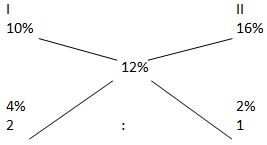Question
Some amount out of Rs. 12000 was lent out at 10% per
annum and the rest amount @ 16% per annum and thus in 5 years the total interest from both the amount collected was Rs. 7200. What is the amount which was lent out at 10% per annum?Solution
Overall interest(SI) = (12000×R×5)/100 = 7200 or R = 12% Using allegation method  Money lent @ 10% = 2/(2+1) × 12000 = 2/3 × 12000 = Rs. 8000
Money lent @ 10% = 2/(2+1) × 12000 = 2/3 × 12000 = Rs. 8000
Consider of the following statement is/are correct about Capital expenditures (CAPEX)?
I. These are often used to undertake new projects or inves...
What is the primary objective of the 'PM Vishwakarma Yojana' scheme?
Which of the following Development Round of WTO was held in 2001?
Polymorphism in fungi was first observed by:
In order to get to the Net Invisibles, we need to fetch the difference between the value of exports and value of imports of invisibles of a country in a...
The book, “An Enquiry into the Nature and Causes of the Wealth of Nations”, (1776) defined Economics as:
Which of the following Organisations is managing the DIKSHA Platform operating under the Samagra Shiksha Abhiyaan?
The Ujjwala 2.0 scheme provides how many free LPG refills to eligible beneficiaries?
Which of the following is not a category under this mission which is described in the above passage?
In order to get to the Net Invisibles, we need to fetch the difference between the value of exports and value of imports of invisibles of a country in a...
Relevant for Exams:



